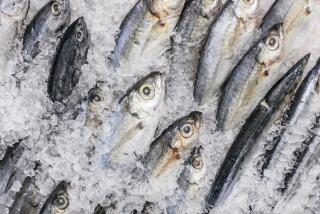Crab Craze Spurs Science to Crack Secrets : Ecology: Maryland loves its blue crab, and so do diners. But with fears that stocks are down, researchers are studying Chesapeake’s population.
- Share via
WASHINGTON — The crack of wooden mallets punctuates hot summer nights at the Bethesda Crab House in suburban Maryland. Red shells, crusted with spice, pile up on newspaper-covered tables. For $14.95, you can eat all you want.
Even on weeknights, most tables are full, and owner Henry Vechery says he sells a hundred dozen Chesapeake Bay crabs on Saturdays. “The whole market’s growing,” Vechery said. “They want to eat them year-round.”
But while the appetite for the bay’s blue crab has never been stronger, there are signs that the crab may not be as abundant as it used to be. More watermen are seeking crabs for more months of the year using increasingly sophisticated equipment, but the average catch is declining.
That has led scientists and environmentalists to try to determine whether the decline is chronic or merely a natural fluctuation in the crab population. And officials in Maryland and Virginia, alarmed by the idea that a symbol of the region could be threatened, are discussing broad limits on crab harvesting.
Scientists are conducting the first accurate count of blue crabs in the Chesapeake Bay, hoping to produce a forecasting tool that could be used to set harvest limits. Last winter, they estimated that 400 million crabs of legal size lived in the bay.
State and federal agencies have spent more than $2 million during the last four years to develop the first accurate Chesapeake Bay crab census and hope to use it to set 1995 harvest quotas.
The count takes place in the cold months--December, January and February--when crabs rest in the bottom mud throughout the 4,000 square miles of the Chesapeake Bay and its tributaries. Dredges drag the bottom at 1,500 locations, and the crab catch is sorted by number, size and sex.
Based on a complex formula, a computer spits out an “index of abundance” for tiny crabs and a count of 1- and 2-year-olds, which usually are large enough to be legally caught.
Scientists still are polishing the forecasting method. They predicted last year’s harvest would be poor, and it was the worst in a decade, which is one factor driving the campaign for crabbing limits. This year’s prediction calls for a somewhat better harvest.
Old beliefs about the crab’s life cycle are toppling in the face of research that employs dredges, computers, glue and electronic tracking devices.
Anxiety about the crab runs high because the bay’s supply of other species also once thought to be boundless--shad, sturgeon, oyster and striped bass--has been gutted by disease, pollution and overfishing.
“As everything else fades out of the picture, there’s nothing left but the blue crab,” said scientist Chris D’Elia of the University of Maryland. “Our resources are limited, whether it’s timber in the Northwest or crabs in the Chesapeake Bay. We can only take so much before we destroy basic stocks.”
No one believes the blue crab is about to be extinct: Catches vary wildly, ranging from 53 million to nearly 100 million pounds in recent years, with values up to about $40 million. It is a hardy shellfish that resists pollution and disease.
The effort to know more about the blue crab is driven by more than economics. For residents and visitors alike, it is a symbol of the region’s uniqueness, and Maryland has honored the crab by naming it the official state crustacean. A staple of the local diet, the crab’s glory days date from the turn of the century, when ice and improved transportation expanded its market inland.
The crab is a vital link in the ecological chain of the Chesapeake Bay: It lives in a wide variety of habitats, is the major consumer of bottom-dwelling fish and is itself consumed by predators.
More to Read
Sign up for Essential California
The most important California stories and recommendations in your inbox every morning.
You may occasionally receive promotional content from the Los Angeles Times.













